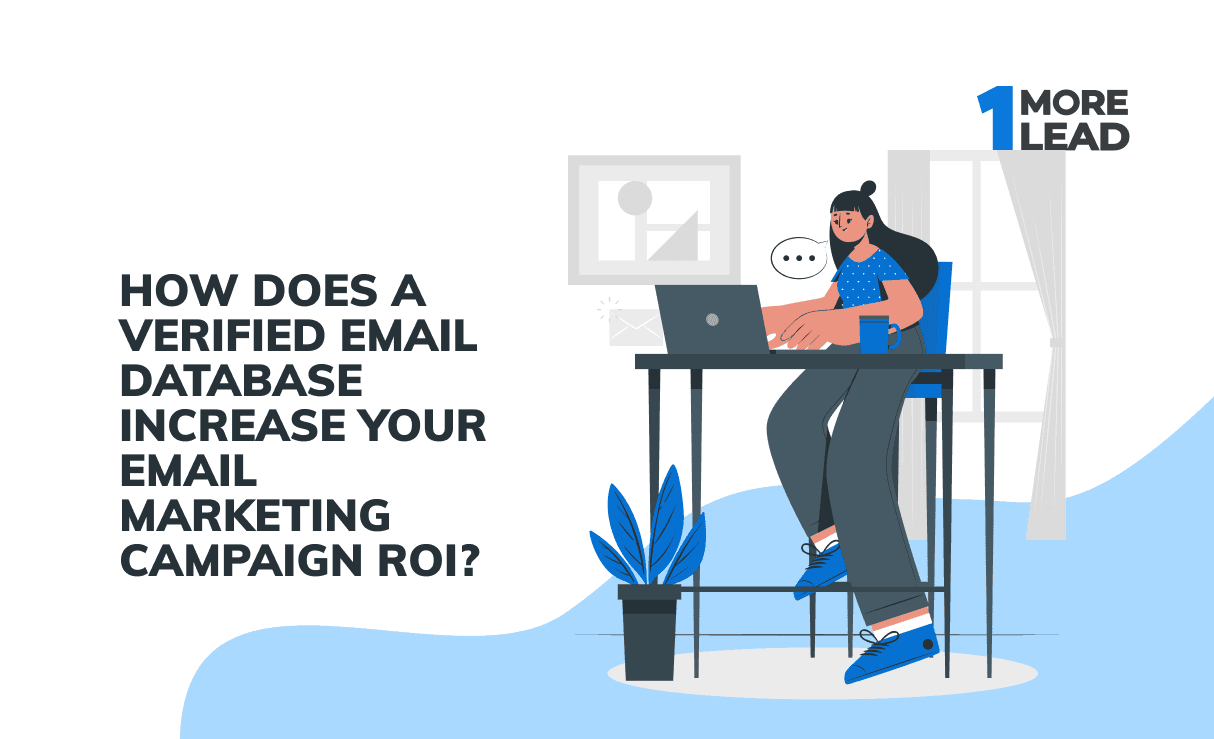
Growing your email list and maintaining your email marketing schedule is a vital part of your marketing strategy. But did you know that email verification is also necessary? Having a verified email database is crucial for every email marketing strategy.

A database is called verified if it contains the precise contact information and where necessary.
When you have a verified email database it is much easier to communicate with your customers. These are the people who have already indicated their interest in getting such messages.
In marketing, email verification is even more critical because company turnover means your business contacts are constantly changing and your email list can quickly decay.
When businesses send bulk emails out to everyone on their decaying lists, they’re including email addresses that no longer exist, emails that never existed, and contacts that are no longer with the business they’re trying to reach.
In fact, 16% of emails never make it to the recipient! When you verify email addresses your email marketing is more effective, fraud prevention is improved and the ability to protect your sender reputation increases.
Email verification is the process of making sure the emails on your list are tied to an inbox. In other words, it’s making sure that the messages you’re sending have somewhere to go.
It is a service that identifies possible spam traps and other email address discrepancies before they're flagged by Internet Service Providers (ISPs) or Email Service Providers (ESPs) and cause permanent damage to your reputation.
In other words, it is the process of checking an email address for being existent and active, or valid.
A valid email is one that can receive messages from other senders. Every email verifier, either bulk or single, performs multiple steps of the verification process. The most common are the syntax, domain, catch-all, and MX record checks, as well as email address ping.
List Verification is the process of removing undeliverable or dangerous emails from your list or database.
Even though most of the marketers nowadays don’t realize this, but in the context of growing your email database, more is not always more. It’s better to have an email database of 100 verified and up-to-date contacts than 1000 unverified email database contacts.
This is true because when marketers build a database with accurate and up-to-date emails, avoiding issues regarding deliverability becomes easier.
It also reduces the likelihood that they’ll get into trouble with their email service provider. In fact, they might also end up paying less for their email marketing campaign.
Real customers start with real emails - and the use of email verification is still the most effective way to ensure the collection of quality data.
Email verification helps ensure that your contact list is accurate and error-free, that the email addresses you have are active, and that they belong to the people you want to reach.
If you are still in doubt about why you need to check email verification, let us show you why email verification matters and why ignoring it when doing email marketing can lead to catastrophic campaign issues that will take weeks to resolve.
Here’s what email verification can help you achieve:
If you are selective with your subscribers and have only verified emails on your list, that will bring you some advantages. First of all, it will build a good foundation for your email marketing strategy.
The goal is to minimize the barging into problems that happen when you send an email to an invalid address.
The solution is quite simple – just use a verified email database.
This way, you’ll be able to enjoy higher deliverability and an open rate. Besides, if you maintain a consistent track record, emails you send to your subscribers will land in their Primary inbox. Not in the Promotions tab, or a Spam folder.
One of the biggest expenses with email marketing is sending out millions of emails to people that do not want to receive them, or worse, do not even exist.
Email addresses that bounce back should have a major impact on your budget. The more contacts you have on your email marketing plan, the more it will cost you. Thus, having extra emails that do not send on your list will increase costs without return.
If you want to avoid wasting money in this area and increase the ROI from your marketing efforts, then it’s essential to build a verified email database that only includes valid, working emails.
Email marketing remains one of the most effective ways of reaching clients. Thus, you must maintain a quality list if you want to build long-lasting relationships with clients proven through opens and click-through rates.
To maximize your audience engagement, start by creating segmented lists using marketing automation software. Remove those that unsubscribe or you get a bounce back from.
If you have high bouncing rates, the effects would be more than just having your emails land in the wrong inbox. You will also make damage to your sender’s reputation. This can potentially get you into problems with your email service provider.
Keep in mind that each email provider has its policy on bouncing and complaint rates. If you develop a bad reputation for spam, it could impact their business.
If you send out a campaign that generates such rates beyond the provider’s allowable limit, you’ll end up with a suspended account. Make sure you send your campaigns only to verified email addresses. This will help you keep your bounce and complaint rates low.
This is quite simple — if you keep sending email campaigns to inactive or non-existent accounts, you’re wasting your time and money. You could probably invest that money somewhere else, and use it smarter.
As mentioned above, ROI is crucial to determining the efficiency of any action. Marketers want to ideally reduce their costs and increase their revenue through their email marketing efforts, which in turn will increase their marketing campaign’s ROI.
The basic formula to calculate ROI is (Money Gained– Money Spent)/ Money Spent.

Email verification helps you increase ROI in both ways – by increasing money gained and by reducing money spent.
Email deliverability is the ability to deliver emails to subscribers’ inboxes. With deliverability, engagement is the most important factor – since it directly impacts sender reputation.
For a stellar sender reputation, you must make sure you are verifying your email lists at a regular interval. This interval will depend on factors such as list decay and the frequency with which you are collecting new emails.
Every time you miss an opportunity to present your campaign to a subscriber, you lose out on a potential sale, or opportunity to build a relationship with them which might lead to a future purchase.
According to a report by TowerData, you can gain $750 for every dollar spent on validating emails.
The same is true for when you end up in the spam folder, where users most likely don’t even look anymore.
For example, if your email list has 80 percent unengaged subscribers (not opened/ clicked in over six months) and sending with this ratio is too frequent, it can lead to rate-limiting or landing in Gmail’s spam folder.
While some individuals may unsubscribe, others will ignore your emails or mark them as spam. This is detrimental to your sender reputation, making your emails less likely to reach the inboxes of recipients, including those that actively engage with your messages.
In simple words email verification is key to maintaining a good sender reputation, consequently avoiding the spam folder, thus maximizing email deliverability.
Bounce rates, open rates, unsubscribe rates, click-through rates, etc. give marketers insight as to how people react to and engage with their emails. Monitoring these metrics over time reveals trends in audience activity and engagement.
Your post-campaign analysis may not give you a correct picture if you did not verify your lists, to begin with.
For example, your bounce rate might be higher, whereas your open and click-through rates are bound to be lower. Having a list with only genuine contacts ensures that your metrics give you a true picture of your email campaign results.
You can cut costs by verifying your emails regularly.
If you have emails that are simply not valid anymore, then you are wasting money on data that won’t provide you any results.
Always remember that you’re paying to send emails, track the analytics, and get your message in front of customers or prospects.
You know that every little bit counts. Email verification eliminates the risk of wasted money from sending messages to fake or toxic emails.
An email blacklist is a real-time database of emails and IPs that, due to poor sending practices, were identified as spammers.
It is important to mention here that, even if you are a legitimate sender, you might still end up on a blacklist.
Finding out your IP or domain has been blacklisted is bad news. Apart from affecting your email deliverability, it takes a lot of time and energy to get out of a blacklist, not to mention the stress and costs.
However, the good news is that these extra costs and unnecessary stress can be avoided. By regularly verifying your lists, you reduce your risk of being blacklisted in the following ways:
It is important to establish a verified email database. Then, you will have a deliverable recipient list to target. Every successful email campaign starts with the email funnel.
You can have the best email template in the world, but if your list is made up of people who do not actually want to receive your emails, you are wasting time and money.
As discussed email verification boosts email ROI in various different ways. Without email verification, your email marketing campaign ROI will keep decreasing, as every month 2% of email addresses in your list become inactive due to various reasons.
Give your beautiful email campaign a real chance of making a difference, by verifying your lists first.
Looking for a tool to search and filter within the database to find the right leads? Get Started with OneMoreLead for free today, and get a database of over 40 Million verified B2B prospects to search from!